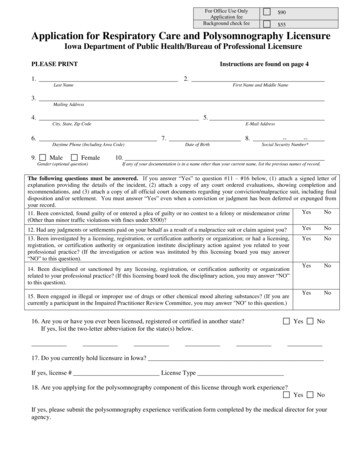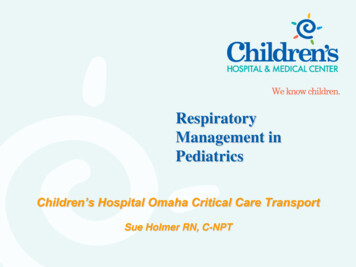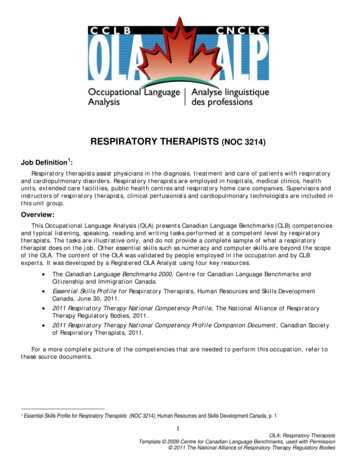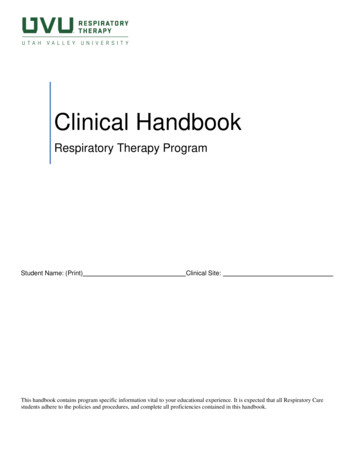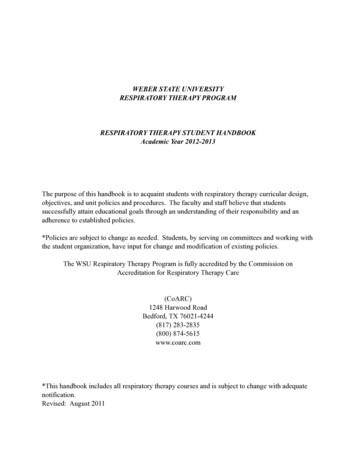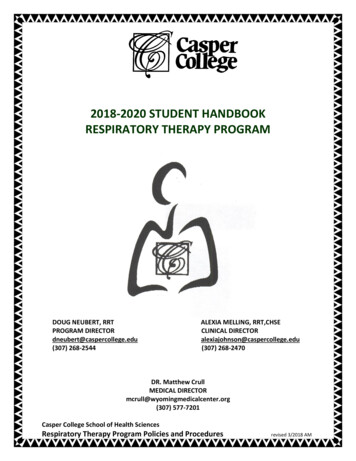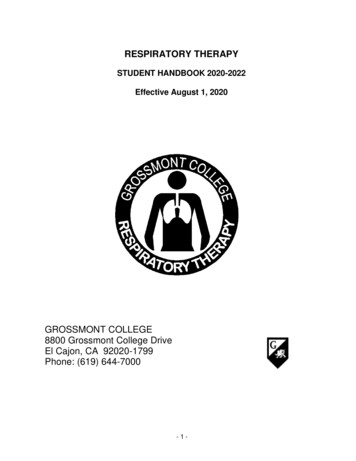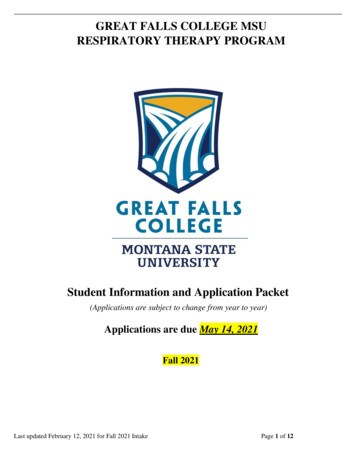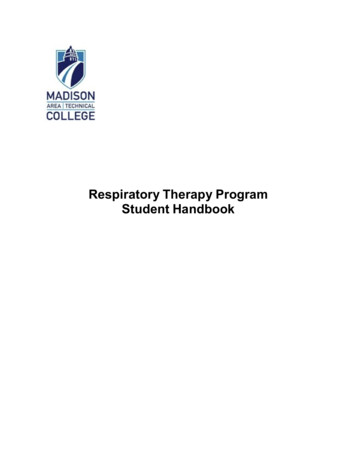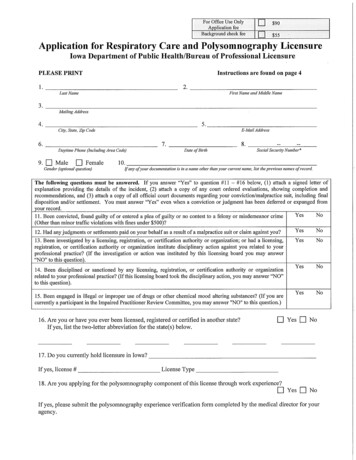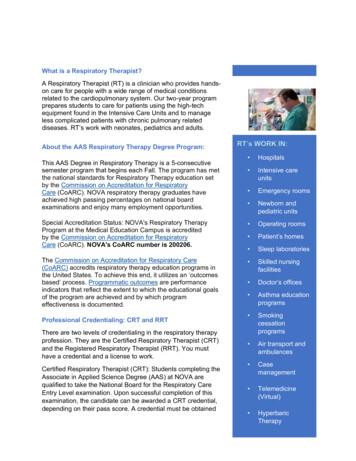
Transcription
What is a Respiratory Therapist?A Respiratory Therapist (RT) is a clinician who provides handson care for people with a wide range of medical conditionsrelated to the cardiopulmonary system. Our two-year programprepares students to care for patients using the high-techequipment found in the Intensive Care Units and to manageless complicated patients with chronic pulmonary relateddiseases. RT’s work with neonates, pediatrics and adults.About the AAS Respiratory Therapy Degree Program: Hospitals Intensive careunits Emergency rooms Newborn andpediatric unitsSpecial Accreditation Status: NOVA's Respiratory TherapyProgram at the Medical Education Campus is accreditedby the Commission on Accreditation for RespiratoryCare (CoARC). NOVA's CoARC number is 200206. Operating rooms Patient’s homes Sleep laboratoriesThe Commission on Accreditation for Respiratory Care(CoARC) accredits respiratory therapy education programs inthe United States. To achieve this end, it utilizes an ‘outcomesbased’ process. Programmatic outcomes are performanceindicators that reflect the extent to which the educational goalsof the program are achieved and by which programeffectiveness is documented. Skilled nursingfacilities Doctor’s offices Asthma educationprograms Smokingcessationprograms Air transport andambulances Casemanagement Telemedicine(Virtual) HyperbaricTherapyThis AAS Degree in Respiratory Therapy is a 5-consecutivesemester program that begins each Fall. The program has metthe national standards for Respiratory Therapy education setby the Commission on Accreditation for RespiratoryCare (CoARC). NOVA respiratory therapy graduates haveachieved high passing percentages on national boardexaminations and enjoy many employment opportunities.Professional Credentialing: CRT and RRTThere are two levels of credentialing in the respiratory therapyprofession. They are the Certified Respiratory Therapist (CRT)and the Registered Respiratory Therapist (RRT). You musthave a credential and a license to work.Certified Respiratory Therapist (CRT): Students completing theAssociate in Applied Science Degree (AAS) at NOVA arequalified to take the National Board for the Respiratory CareEntry Level examination. Upon successful completion of thisexamination, the candidate can be awarded a CRT credential,depending on their pass score. A credential must be obtained
before applying for licensure in Virginia and most other states. We have a 99% first-time passrate on this exam.Registered Respiratory Therapist (RRT): The highest level of practice is that of RegisteredRespiratory Therapist (RRT). You become eligible for this examination after completion of theNOVA AAS Respiratory Therapy program degree. You must have a minimum of a CRT andmost hospitals will require that you earn the RRT within a certain timeframe as a contingency ofemployment. The national Board for Respiratory Care (NBRC) now requires all CRTs to takeand pass the RRT exams within 3 years of obtaining the CRT credential. See www.nbrc.org.The Registry credential is required of persons seeking education and management positions.Registered therapists generally command higher salaries and have greater job mobility.How do I apply?Each year we accept 25 full-time students into the freshman class with competitive admission.Should there be more applications than openings, the Allied Health Division accepts students asfollows: In-state students from our service area In-state students from outside our service area Out-of-state students International applicants requiring Form I-20What’s next?Step 1: Listen and read a mandatory respiratory therapy information session ONLINE. Write theInformation Session Code on the application. Congratulations-you’ve completed the first step!Step 2: NOVA application on file. If you have not applied to the college, you need to complete an “Application for Admission.”Click on the LEARN MORE – HOW TO APPLY button on this page. If you have any questionscontact student services at 703-822-6557 or meccounselor@nvcc.edu.Step 3: To be considered, you must have a minimum of a 2.5 GPA from your the last school youattended. This will include grades from prerequisite courses. Have your previous college transcripts sent to this address for evaluation: Medical EducationCampus Student Services Rm 202, 6699 Springfield Center Drive Springfield, VA 22150-1913 After NOVA receives them, you will need to complete a “Request for transcript evaluation”form. There is a link to this form on the information session web page. Turn this form in toSTUDENT SERVICES in room 202 at the MEC. (Everyone will have college transcripts due to the prerequisites. Sending your high schooltranscripts is not necessary).Step 4: Completes ENG 111
CLEP test is available (see Student Services Office at MEC (room 202)Step 5: Qualifies for MATH 154Visit the Math Discipline site for updated information.Step 6: BIO141/BIO142 or NAS161/NAS162* -prerequisite course sequences. You chooseeither the BIO series or the NAS series. A grade of C or better needs to be achieved in thesecourses. The program prefers BIO141/142 as they also work in an Associate of Science degreeand for transferring to a 4-year program in the future: BIO141/BIO142 will transfer.NAS161/162* will not easily transfer. Preferred sequence of Anatomy & Physiology courses is BIO141/BIO142Step 7: Complete prerequisites ENG 111: College Composition I BIO141/BIO142 or NAS161/NAS162* HLT 141: Medical Terminology (or HIM 111) grade of C is or better is required SDV 101: Orientation to Health Care (or any other SDV course) RTH 120: Fundamental Theory for Respiratory Care: grade of B or better is requiredStep 8: Complete the ALLIED HEALTH Application. Mail the application, certified mail, to:Medical Education Campus Student Services HE 202, 6699 Springfield Center DriveSpringfield, VA 22150 3 Upon application acceptance and approval, you will receive a letter confirming your admittanceto the program or a letter that states that the program has been filled.§Check the Allied Health Application for dates that We will be accepting ALLIEDHEALTH APPLICATIONS for respiratory therapy.How many new students do you accept each year?We accept students on a competitive admission basis for each fall. Each program position isconsidered filled when the student enrolls in the fall courses with courses paid.The first 25 students are given time to register. If they do not register, they forfeit their spot, andthe next person in the alternate line is contacted via a competitive admission basis. Thiscontinues until we reach full capacity or the fall semester starts.Any additional requirements?All Allied Health Students are required to pass the “Preadmission Health Form”, a criminalbackground check and drug screen and maintain a current healthcare provider CPR certificationthrough the American Heart Association. The criminal background check/drug screen must becompleted immediately after acceptance into the program. The criminal background check/drugscreen parameters are based on our clinical affiliates (hospitals) requirements. Students mustmeet these requirements for clinical rotations prior to the program starting. Students unable topass/complete these requirements will be administratively withdrawn from the program.
This is the list of items needed before your clinical rotation placement completed. This is doneduring the first semester: “Preadmission Health Form”- with current immunizations Background check/Drug screenHealthcare provider CPR certification from American Heart AssociationAnnual TB test- first test is to be a 2-step testAnnual Flu shot- dates for flu shot determined by the hospitals Liability InsuranceWhat you can do now? Take support courses when your prerequisites are complete:§§§§CST Elective: We suggest CST 229. Other acceptable courses are CST 110,CST 115 or CST 126PED 116 – 1 credit version Fitness and Wellness – no other substitutesOne (1) Humanities Elective: any 3-credit course as listed in catalog underHUMANITIES. We suggest PHI 227- Biomedical EthicsOne (1) Social Science Elective: any 3-credit course in (PSY, ECO, SOC, GEO,HIS, Political Science) Learn more about the profession see: AARCWhat is the time and financial commitment?Our most successful students suggest an average of 2-hours a night of studying. Some studythe night after each class, others do it all on the weekend. Whatever works best for you, but youmust study consistently. For the most current information on tuitionWhen do we go to class?Most RTH lecture courses are on Tuesday and Thursdays between 0800-1600. Some labsections and classes are held on Wednesdays or Fridays as well. You are in class and lab atotal of 19 hours a week plus study time of at least 10 hours/week for a total of 29 hours/week.Beginning the second semester clinical instruction is done on Monday and Wednesday between0700-1400. In addition, there are classes Tuesday and Thursday, and may be a lab on Friday.During the second semester, you will spend an average of 27 hours each week in class, lab orclinical. Plus, you need to study at least 10 hours a week. This time commitment continues forthe remaining semesters.What is the Employment Outlook and Salary?For NOVA graduates staying in this area, the starting salary is around 55,000. 00. Hospitalbenefit packages in general are very good, but vary by institution. Many hospitals offer 12-hourshifts which translates into 12-days a month. BS degrees in Respiratory Therapy can be foundat several Universities online and some in the area where education is a continuation from theAAS degree level.Contact Information:Program Director: Donna Freeman, MS, RRT
Email: dfreeman@nvcc.eduPhone: 703-822-2093Admin. Assistant: Elvira NevarezEmail: ENevarez@NVCC.eduPhone: 702-822-6557*NAS 161 and 162 will be accepted through 2020 only.Revised August 2018
What is a Respiratory Therapist? A Respiratory Therapist (RT) is a clinician who provides hands-on care for people with a wide range of medical conditions related to the cardiopulmonary system. Our two-year program prepares students to care for patients using the high-tech equipment found in the Intensive Care Units and to manage
